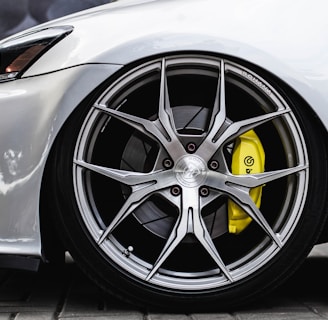SAME DAY and contact-less service AVAILABLE!
for optimal desktop viewing set zoom to 100%
Paint Correction
Paint correction is an essential step in car detailing that helps restore your vehicle’s paint by removing imperfections like swirl marks, scratches, oxidation, and water spots. This process not only enhances the clarity and shine of your car but also improves the longevity of the paint by maintaining its protective clear coat. In this guide, we’ll walk you through the fundamentals of paint correction, why it’s crucial for your vehicle, and the steps involved in achieving a flawless finish. We’ll also highlight how Snyder’s Squeaky Clean handles paint correction with precision, ensuring your car always looks its best.
Glen Snyder
11/5/20244 min read
What Is Paint Correction?
Paint correction is the process of using abrasive compounds to remove a fine layer of clear coat, effectively leveling out minor imperfections like swirl marks, light scratches, water marks and oxidation. This technique restores the paint’s gloss, creating a smoother and more reflective surface.
Why Is Paint Correction Important?
Enhancing Shine and Depth: Revitalizes the paint’s clarity, making colors appear richer and more vibrant. This is especially valuable for darker paint colors that easily show defects.
Reducing Defects: Everyday wear and tear, such as washing swirls and light scratches, can dull the paint. Paint correction address these defects, making the surface smoother and more uniform.
Maintaining Value: Regular servicing helps maintain a vehicle's value, especially if you're considering resale. A well-kept exterior with minimal scratches and oxidation appeals more to potential buyers.
Improving Wax and Sealant Bonding: Corrected paint provides a smooth surface, allowing protective products like wax or sealants to adhere better. This improves the durability of the protection and extends the shine.
When You Shouldn’t Perform Paint Correction
Paint correction can significantly enhance your car’s finish by removing defects, but there are situations where it should be approached with caution—or avoided entirely. Since paint correction involves removing a portion of the clear coat to level imperfections, understanding when not to proceed is crucial.
1. Thin or Worn Clear Coat
Aggressive paint correction can excessively thin the clear coat, reducing its ability to protect the underlying paint. The average factory clear coat thickness ranges from 1.5-2.5 mils (38-63 microns)—for reference, a standard sheet of printer paper is about 3.95 mils (100 microns). If your clear coat measures below 1 mil (25 microns), paint correction is not recommended, as it risks burning through the layer entirely, exposing the base coat and causing irreversible damage.
2. Vehicles That Have Undergone Multiple Corrections
Repeated paint correction sessions can dangerously reduce clear coat thickness over time. Each correction removes a thin layer, with varying levels of abrasiveness:
Mild correction removes around 0.1-0.3 mils (2.5-7.5 microns).
Medium correction removes 0.3-0.5 mils (7.5-12.5 microns).
Heavy cutting compounds can remove up to 1 mil (25 microns) or more in a single session.
For long-term paint protection, at least 1 mil (25 microns) of clear coat should remain intact. A paint thickness gauge can help determine if further correction is safe.
3. Fresh or Recently Painted Surfaces
Newly applied paint or a fresh respray needs time to fully cure—typically 30-90 days, depending on the type of paint used. Performing paint correction too soon can interfere with the curing process, weakening the paint structure and leading to defects. Always consult the painter or body shop before attempting any correction on fresh paint.
4. Severely Oxidized or Aged Paint
Older, heavily oxidized paint—particularly on single-stage finishes (without a clear coat)—can be unstable. Aggressive correction may accelerate deterioration rather than improve the appearance. In such cases, it’s best to seek professional advice, as alternative treatments like paint nourishment or specialized restoration techniques may be more suitable.
Types of Polishes and Compounds
Choosing the right polish or compound is essential for effective results:
Cutting Compounds: Highly abrasive and used for deep scratches or heavy oxidation. They should be followed by finer polish to restore clarity.
Medium Polishes: Medium abrasives are used for moderate defects like swirls and water spots. They balance cutting power and finish quality.
Finishing Polishes: Lightly abrasive, used to enhance the paint’s final shine after using a cutting or medium polish.
Water-Based vs. Oil-Based Polishes: Water-based polishes are easy to clean and safer for paint, while oil-based polishes can produce longer-lasting shine, especially on harder paints.








Conclusion
At Snyder’s Squeaky Clean, we understand that your vehicle’s appearance is important to you. Paint correction is a powerful way to restore your car’s shine by removing imperfections like scratches, swirl marks, and oxidation. However, it’s essential to do it correctly to protect your vehicle’s clear coat and maintain its long-term value.
Our expert team is here to assess your paint’s condition and provide professional correction services tailored to your car’s needs. With the right techniques and high-quality products, we ensure a flawless finish that enhances and protects your vehicle. Contact us today to learn how we can bring back that showroom shine while keeping your paint in top condition for years to come!
What We Offer
Here at Snyder’s Squeaky Clean, we proudly offer a 1-Step Paint Correction Service, designed to enhance your vehicle's appearance with a focus on efficiency and quality. This process is perfect for cars with light to moderate imperfections, such as swirl marks, minor scratches, and oxidation, that don’t require a full multi-step correction.
Our 1-step paint correction involves the use of a carefully selected polish and pad combination that both removes minor defects and restores a stunning gloss in a single pass. This service is a time-effective solution that delivers noticeable improvements without the extensive time commitment or cost of a multi-step process.
By choosing our 1-step paint correction, you’ll enjoy a refreshed, vibrant finish that highlights your vehicle’s beauty while maintaining its value. As a mobile auto detailing service, we bring this premium treatment directly to your location, ensuring convenience and satisfaction every step of the way.

